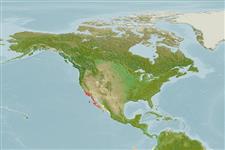>
Gobiesociformes (Clingfishes) >
Gobiesocidae (Clingfishes and singleslits) > Gobiesocinae
Etymology: Rimicola: Latin, rima, -ae = crack, cleft + Latin, colere = to live.
More on author: Gilbert.
Environment: milieu / climate zone / depth range / distribution range
Ecologia
marinhas demersal; intervalo de profundidade 0 - 15 m (Ref. 2850). Subtropical
Eastern Pacific: near San Pedro in southern California, USA to southern Baja California, Mexico.
Tamanho / Peso / Idade
Maturity: Lm ? range ? - ? cm
Max length : 5.7 cm TL macho/indeterminado; (Ref. 2850)
Descrição suscinta
Chaves de identificação | Morfologia | Morfometria
Espinhos dorsais (total) : 0; Raios dorsais (total) : 5 - 8; Espinhos anais: 0; Raios anais : 5 - 8; Vértebras: 33 - 35. Branchiostegal rays: 6 (Ref. 36496).
Adults occur in the intertidal and shallow subtidal to 15 m depth (Ref. 2850). Feed almost exclusively on tiny crustaceans (Ref. 4930). Oviparous, with planktonic larvae (Ref. 36496). Eggs are demersal attached to stones or cobbles (Ref. 36496).
Ciclo de vida ou comportamento de acasalamento
Maturities | Reprodução | Spawnings | Egg(s) | Fecundities | Larvas
Eschmeyer, W.N., E.S. Herald and H. Hammann, 1983. A field guide to Pacific coast fishes of North America. Boston (MA, USA): Houghton Mifflin Company. xii+336 p. (Ref. 2850)
Status na Lista Vermelha da UICN (Ref. 130435)
Ameaça para os humanos
Harmless
Uso pelos humanos
Ferramentas
Relatórios especiais
Baixar XML
Fontes da internet
Estimates based on models
Preferred temperature (Ref.
123201): 12.8 - 25.6, mean 18.1 °C (based on 92 cells).
Índice de diversidade filogenética (Ref.
82804): PD
50 = 0.5312 [Uniqueness, from 0.5 = low to 2.0 = high].
Bayesian length-weight: a=0.00617 (0.00250 - 0.01521), b=3.15 (2.94 - 3.36), in cm total length, based on LWR estimates for this (Sub)family-body shape (Ref.
93245).
Nível Trófico (Ref.
69278): 3.5 ±0.50 se; based on food items.
Resiliência (Ref.
120179): médio(a), tempo mínimo de duplicação da população 1,4 - 4,4 anos (Preliminary K or Fecundity.).
Fishing Vulnerability (Ref.
59153): Low vulnerability (10 of 100).
